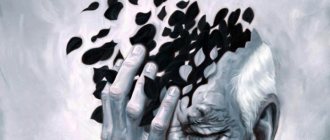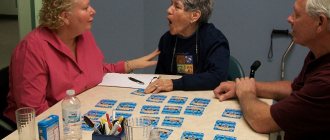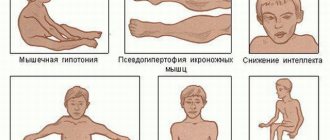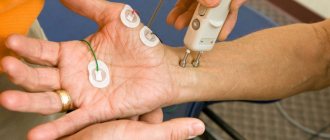Dementia is a syndrome in which there is a degradation of memory, thinking, behavior and the ability to perform daily activities to the point of degradation and destruction of the personality itself. DE - absence, MENZ - mind.
Dementia in the elderly (or as it is often called “senile dementia”) is usually characterized as an irreversible decline in cognitive (mental) functions with loss of short-term memory, caused by organic brain damage as a result of one or another neurodegenerative disease. Most often, dementia develops as a result of Alzheimer's disease (75%) or a general decrease in blood supply to the brain, local infarction, ischemic stroke (vascular dementia).
Unfortunately, we have insufficient awareness of society and diagnosis of dementia at an early stage, so many people with varying degrees of dementia simply do not turn to anyone for help and sit at home. Relatives attribute the decline in mental functions of loved ones to age: “Well, what do you want, mom (dad) is already 80 years old.” And this situation continues until the already sick person himself cannot live alone. Then the alarm begins to sound, and this is at least the middle stage of dementia.
It is very important to understand that age and dementia are not the same thing . Yes, neurodegenerative diseases are primarily diseases of old age, but not all older people have them, and not all older people have dementia.
Signs of dementia
- impairment of short-term memory. At the same time, events that happened many years ago may appear in small details;
- behavior change. The manifestation of individual character traits intensifies, suspicion, sloppiness, suggestibility, and apathy appear;
- confusion in an unfamiliar environment. At home, the patient remembers where he is, but on the street he may forget where he needs to go;
- confusion of thinking. The thread of the conversation is often lost; by the end of the sentence the patient does not remember what he said at the beginning;
- slowing down reactions.
Causes
For a long time, the main cause of vascular dementia was considered to be acute cerebrovascular accidents (hereinafter referred to as ACVA, which means, first of all, stroke). A stroke develops as a result of blockage of an artery by an embolus or thrombus (ischemic stroke) or when an artery ruptures and hemorrhages in the brain (hemorrhagic stroke). In this case, due to lack of nutrition, neurons die.
After a stroke, the likelihood of developing vascular dementia increases significantly. Within 1 year after a stroke, vascular dementia develops in a quarter of patients. The nature of the manifestation of symptoms depends on the area of the brain in which the disorder occurred. The size of the lesion also plays a role. Vascular dementia usually develops when more than 50 ml of brain volume is affected.
However, if circulatory disorders occur in areas important for cognitive functions (visual thalamus, hippocampal region, frontal prefrontal cortex, etc.), then a smaller area of neuronal death can lead to the development of vascular dementia. If other areas are affected, motor disorders and other post-stroke manifestations may occur.
It has now been established that vascular dementia is not always associated with acute disorders. It can occur due to a chronic dyscirculatory process - blockage of small vessels that occurs unnoticed by the patient (the so-called subcortical vascular dementia). It has also become possible to detect these disorders thanks to the spread of digital technology and the spread of neuroimaging methods in medicine.
Neuroimaging (functional MRI, PET, etc.) allows one to observe “silent” areas of vascular lesions in the brain that previously went unnoticed as not leading to an acute lesion (stroke). The development of vascular dementia is possible with a decrease in blood perfusion in the brain.
This occurs against the background of acute or decompensated chronic heart failure, a decrease in circulating blood volume, and a sharp decrease in blood pressure. All these phenomena lead to insufficient blood supply in the peripheral microcirculatory zones of all vascular beds and neuronal death. Based on this, the occurrence of vascular dementia is influenced by two components: stroke and a chronic discirculatory process. When these disorders occur simultaneously, they reinforce each other, leading to more pronounced symptoms.
Let's consider the mechanism of development of vascular dementia.
When the vascular link in various parts of the brain is damaged, neurons do not receive the required amount of oxygen and nutrients, which leads to the death of these cells. Initially, the brain compensates for the violations - they do not appear externally. Over time, the potential is depleted, negative changes begin to affect the state of memory, speech, concentration and speed of thinking. As a result of these cognitive disorders, a person’s behavior changes, and his independence decreases.
All types of vascular dementia account for up to 15% of all cases of dementia in the elderly. There are also often cases of mixed dementia, which combine vascular dementia with Alzheimer's disease. It is believed that as a person ages, the risk of vascular dementia decreases, while the risk of developing Alzheimer's disease increases.
In this regard, the vascular factor is recognized as especially dangerous in the Russian Federation, where life expectancy is still not very high and part of the population simply does not live to the age of onset of another type of dementia. Vascular dementia is also widespread compared to Alzheimer's disease in some Asian countries (Japan, China), and a number of Scandinavian countries (Finland, Sweden).
Risk factors for vascular dementia are:
- high or low blood pressure,
- cerebral atherosclerosis,
- hyperlipidemia,
- cardiac ischemia,
- diabetes,
- arrhythmias,
- hyperhomocysteinemia (now this factor is considered doubtful),
- pathology of heart valves,
- vasculitis.
Smoking, poor diet and a sedentary lifestyle contribute to the risk of developing vascular dementia.
Stages of dementia development
- Initial stage: Intellectual abilities decrease, self-service skills are preserved.
- Middle stage: Skills in using familiar things decrease, forgetfulness of recent events and people's names worsens, orientation at home is disturbed, difficulties in communication increase, behavioral changes appear, expressed in aimless walking or asking the same questions.
- Late stage: Inappropriate behavior that may worsen and include aggressiveness, disorientation in time and space, difficulty recognizing family and friends, difficulty moving, impaired speech and difficulty swallowing.
Symptoms
As a rule, “vascular dementia” is diagnosed if cognitive impairment was preceded by a stroke. Quite often, accompanying signs are symptoms of focal brain damage, for example, manifestations of hemiparesis (weakness of the muscles of one side, anisoreflexia, pathological foot signs, etc.). A characteristic symptom is a walking disorder - a slow, shuffling gait and instability (which patients themselves often call dizziness).
As mentioned above, the cause of vascular dementia lies in circulatory disorders in the brain. The potential for disturbances to occur exists in different areas of the brain. Therefore, the external manifestations of vascular type dementia differ significantly in each case. Let's list the most typical ones.
Dementia caused by damage to the midbrain is manifested by mesencephalothalamic syndrome. The first manifestations are confusion and hallucinations. A person becomes apathetic, withdraws into himself, does not care about his appearance, and neglects personal hygiene. His psychophysiological state is usually characterized by increased drowsiness. In some cases there are speech disorders.
In dementia caused by damage to the hippocampus, first of all, there is an impairment in the ability of memory to retain information about current events (long-term memory can be retained).
As a result of a stroke, apathetic-abulsic syndrome is observed in the prefrontal regions of the frontal lobes. The patient behaves inappropriately, there is no criticism of the condition. Inadequacy consists in repeated repetition of one’s own words and actions, or the words and actions of others.
Subcortical lesions lead to disruption, first of all, of daily activities: it is difficult for the patient to concentrate on one subject and maintain one type of activity; problems arise with making plans. There is also a violation of the skills of information analysis (separation of the main from the secondary).
A stable sign of vascular dementia is impaired urination; it is observed in almost all persons suffering from dementia.
Symptoms of vascular dementia are also noticeable in the psycho-emotional sphere. There is a general decrease in mood and self-esteem, emotional instability, depression appear, and self-confidence is lost.
Last stage
The late stage is characterized by a complete loss of independence. As a result, the patient forgets even the most basic things. These are such simple everyday skills as, for example, holding a spoon and whether it is even needed. Or, for example, how to go to the toilet, what clothes to wear and much more. Unfortunately, at this stage, a person with dementia forgets a lot. He forgets the names of loved ones, the names of household items, gets lost in space, and stops taking care of himself. Unfortunately, the progression of symptoms leads to complete collapse of the personality.
The first symptom that an older person with dementia may notice is memory loss. What grandparent doesn't forget something due to absent-mindedness? Yes, often even doctors cannot determine the disease with high accuracy. And the person continues to live his life. What makes the situation worse is the fact that the patient himself cannot understand that he is sick. Of course, you can’t take it to the last stage, so it’s important to pay attention to the symptoms. On the first day, you can invite an elderly relative to take the test described below. And, of course, contact a neurologist and psychiatrist. The doctor will conduct a consultation and use special techniques to check the patient’s cognitive functions.
Treatment
Treatment of vascular dementia should be aimed at correcting the pathological factors leading to this condition, as well as directly correcting cognitive functions. It makes no sense to describe all kinds of treatment regimens and give the names of specific drugs with their course and single doses in this article, because each specific case requires an individual approach.
The general principles of therapy for vascular dementia should be the correction of hypertension and cholesterol levels (however, you should not reduce cholesterol levels below 3.5-4 mmol/l due to the risk of a combination of Alzheimer's disease and vascular dementia, and Alzheimer's disease reacts negatively to low cholesterol levels , although, unfortunately, it is not entirely clear why), as well as the use of antiplatelet or anticoagulant therapy.
It is important to carry out a course of treatment with antioxidant (Mexidol, Cytoflavin, etc.), neuroprotective (Actovegin, Ceraxon, Cortexin, etc.), vasoactive (Sermion, Cavinton, etc.) drugs, with individual selection based on availability contraindications in the patient and the clinical picture as a whole, as well as (the author’s opinion), anti-dementia drugs should be used, and the drug of choice should be memantines (Akatinol, Marux, etc.).
An equally important point is non-drug therapy, namely proper patient care and psychological comfort. After all, if you are surrounded by close people, and they treat you with a positive attitude, life becomes a little better.
How to care for someone with dementia
Elderly patients with dementia require constant care. Patients themselves, as well as those caring for them, experience great emotional and physical stress. An elderly patient is unpredictable; at any moment he can commit an inappropriate act and endanger not only himself, but also those around him. Therefore, such persons often suffer from discrimination against them. This happens especially often in nursing homes, where elderly patients are cared for by strangers who do not fully understand the essence of the disease. There are known cases of rude treatment of elderly patients and their relatives by medical personnel. If society becomes more aware of what dementia is, the situation could improve significantly.
Dementia in old age is not a death sentence. All that is required from relatives is an understanding that their loved one needs care and help in everyday life. Family members can make the environment safe by being considerate. Patience is important in providing complete care.
Regular examination of an elderly patient by a doctor and monitoring of medication intake is necessary. Medicines should not be in the public domain.
Unfortunately, the prognosis for elderly patients is quite disappointing. The process of mental degradation is irreversible, it cannot be stopped, but it is quite possible to slow it down so that the patient can lead a full life in society longer.
Life expectancy with this disease can vary from several months to decades. Timely therapy and regular training aimed at improving memory and attention are especially important. It would be reasonable to place the elderly patient in a special geriatric center for ongoing medical monitoring.
The following are used as preventive measures:
- control of blood pressure, cholesterol and sugar levels (after 60 years);
- rejection of bad habits;
- constant physical activity;
- regular mental training;
- proper nutrition.
To avoid dementia in old age, it is necessary to constantly train the brain, develop memory and attention. To do this, you should read books and retell them to others, count and add up prices in the store in your mind, and solve crosswords. Sometimes preventing a disease is much easier than dealing with its consequences.
We recommend
“Boarding house for elderly people with dementia: how to make the right choice” Read more
Modern methods of treating dementia
In the 21st century, new developments in the field of recognition and treatment of dementia in old age are constantly emerging. For example, modern diagnostic methods include cerebrospinal fluid analysis, MRI and positron emission tomography.
Some laboratories are working on a vaccine for dementia. Scientists “train” the immune system to identify pathogenic proteins and eliminate them.
Another promising area is gene therapy. It will help prevent the deposition of affected proteins in the brain.
We recommend
“Anti-dementia drugs for the elderly depending on the stage of the disease” Read more
Vascular dementia
Of all types of senile dementia, 20% of cases are due to dementia of vascular origin. This species ranks second after Alzheimer's disease.
Dementia stands apart against the background of vascular accidents:
- hemorrhagic stroke, in which brain vessels rupture;
- ischemic stroke, during which blockage of blood vessels occurs and blood circulation in a specific area worsens or stops.
In these situations, brain cells die en masse, with focal symptoms most clearly manifested, which depend on the location of the affected areas. The clinical pictures of dementia after stroke are varied. It is important how severely the vessels are affected, what is the area of the blood supply to the areas of the brain. Much will depend on the compensatory capabilities of each individual organism. In case of vascular injury, timely and adequate medical care is of great importance.
Dementia of old age, resulting from chronic circulatory deficiency, occurs in a more homogeneous clinical picture.
We recommend
“Vascular dementia: symptoms, diagnosis and treatment methods” Read more









